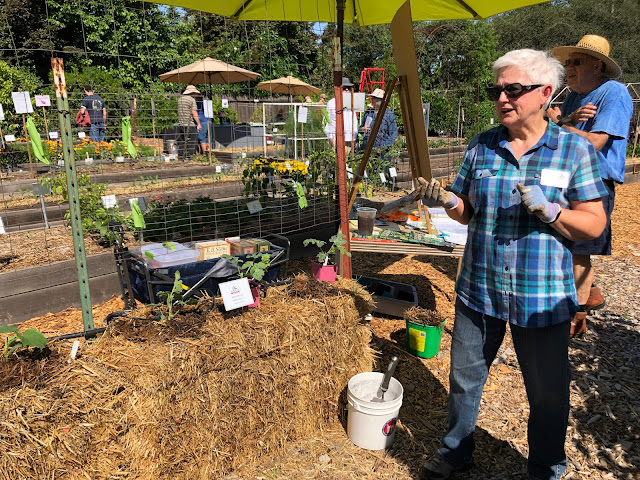
|
|
Master gardener Gail Pothour talks about growing cucumbers in straw bales during the May 2019 Open Garden at the Fair
Oaks Horticulture Center. Although the 2020 spring gardening events have been canceled, gardeners can turn to UCCE and other reliable sources of information online. (Photo: Kathy Morrison)
|
Create a self-taught course from some of these West Coast-centric sources
The in-person workshops, open gardens and demonstrations will have to wait until next spring in the Sacramento area, but anyone who is serious about vegetable gardening this spring can find a wealth of information, videos and even classes online.
First, a warning: Do not dive headlong into YouTube. It's the easy answer, but without a very specific search, it's' a deep rabbit hole that will waste your time. Building a raised bed or constructing a straw bale garden is a universal topic, but when it comes to planting and growing, look hard for climate-specific information. How many of those gardening videos are by California gardeners, or even West Coast ones? If you can't tell where they're coming from, bail out.
OK, that's out of the way. With a hat tip to Sacramento County master gardener Gail Pothour, the vegetable guru at the Fair Oaks Horticulture Center, for many of these links, here are some great sources of information:
Peaceful Valley Farm and Garden Supply
in Grass Valley, which is open now only for online sales, has a terrific library of
online videos
for growing fruits and vegetables. Each is just a few minutes long. Put "vegetables" into the search bar and you get 163 results! I like their video on
Vegetable Garden Myths
. They have resources to print out, too -- their
Fertilizer Solutions Chart
is excellent.
"Farmer Fred" Hoffman not only has useful radio gardening shows on KFBK and KSTE every Sunday (also available later in the week via
KFBK Garden Show
and
Get Growing With Farmer Farmer
podcasts) but he has a slew of gardening resources on his website,
farmerfred.com
. The single most useful one I find is the "weekly average soil temperature" guide, which Fred breaks out for the valleys (53-56 degrees F this week), lower foothills (57) and upper foothills (48).
By the way, horticulture expert Debbie Flower will discuss "Vegetable Gardening Basics" with Fred this Sunday; tune in at 8 a.m. to 1530-AM/93.1-FM for the first show and at 10 a.m. to Talk 650 KSTE for the second show. You can also listen live via the stations' websites (links on Fred's website).
If you have the time to watch a lecture (slides plus narration, really), Oregon State University is offering its master gardener
Vegetable Gardening Short Course
at no charge during April. (Usually it's $45.) Registration is required, however. My Sacramento master gardener training class already has taken this; the photos are particularly useful. You just have to remember that they're talking about Oregon's climate and not ours.
And of course, the Sacramento County master gardeners (home page at
sacmg.ucanr.edu
) and the UC Cooperative Extension (part of the UC Division of Agriculture and Natural Resources) have a
huge list of guides
to just about anything you want to grow. I especially like this
tomato one
.
Some of the guides are written for Sacramento County specifically, others -- such as from the UC Integrated Pest Management site -- are for California as a whole. (The way they define it, pests aren't just bugs but also diseases and disorders.) Check these out:
-- If you don't look up anything else, read
Vegetable Gardening 101
(EHN 96) for the single best general guide to growing veggies in the Sacramento area.
-- This
Sacramento Vegetable Planting Schedule
(EHN 11) is hugely useful, as is this chart on
Soil Temperature Conditions for Vegetable Seed Germination
(GN 154).
-- Requirements for
blueberries
and
cane berries
can be very confusing; click on the links to find succinct info on these crops in our area.
-- The
California Garden Web
has loads of information, available in a FAQ format. Topics include using compost, choosing fertilizer, and "how do I grow?" info on everything from
artichokes
to
watermelons
. (Note on the artichokes: This publication doesn't recommend planting them in the interior valleys, which includes us, but I've grown them. The plants need some afternoon shade and plenty of water. So know your microclimate!)
-- Managing pests in the vegetable garden.
This link
takes you to other links on solving problems for more than 20 commonly grown vegetables.
-- A
weed identification gallery
is also available.
-- UC IPM recently added a
Plant Problem Diagnostic Tool
which can be very useful.
This is just a glimpse of the good, solid information that's out there for Sacramento-area vegetable gardeners. Explore, and have fun!
